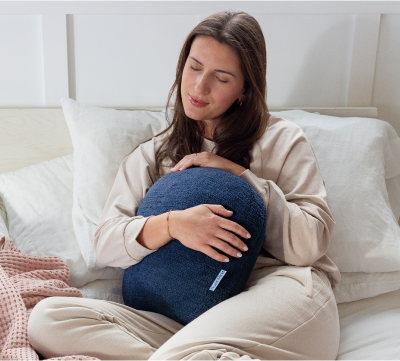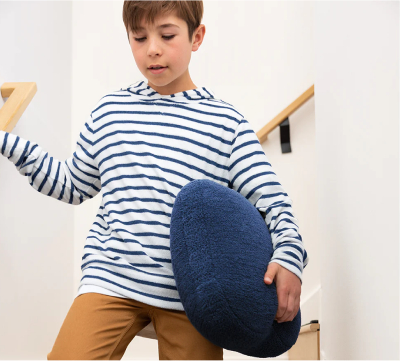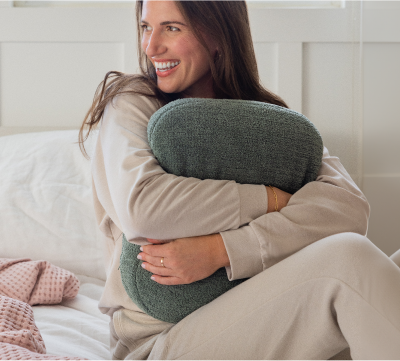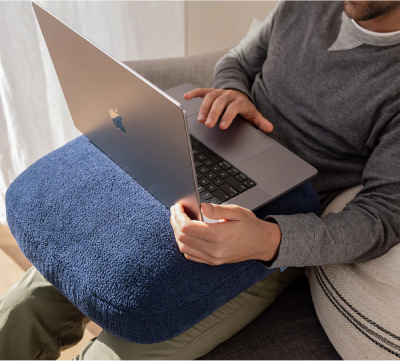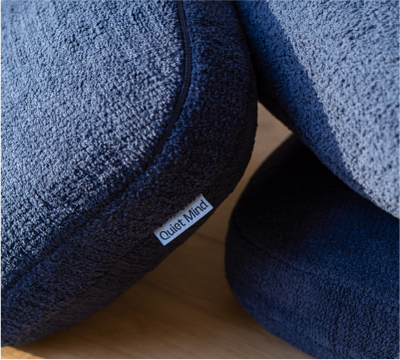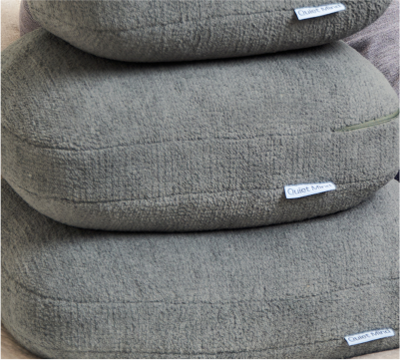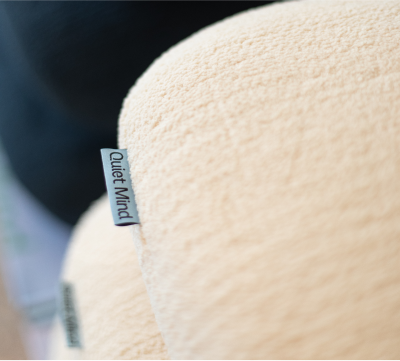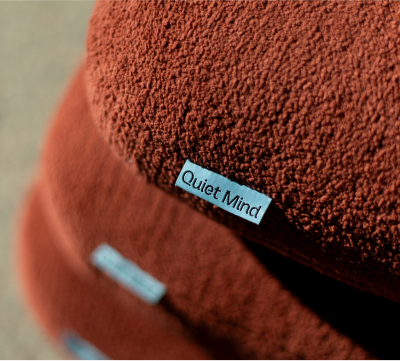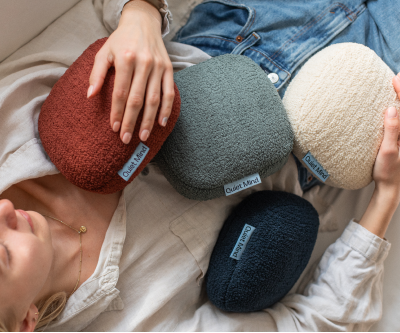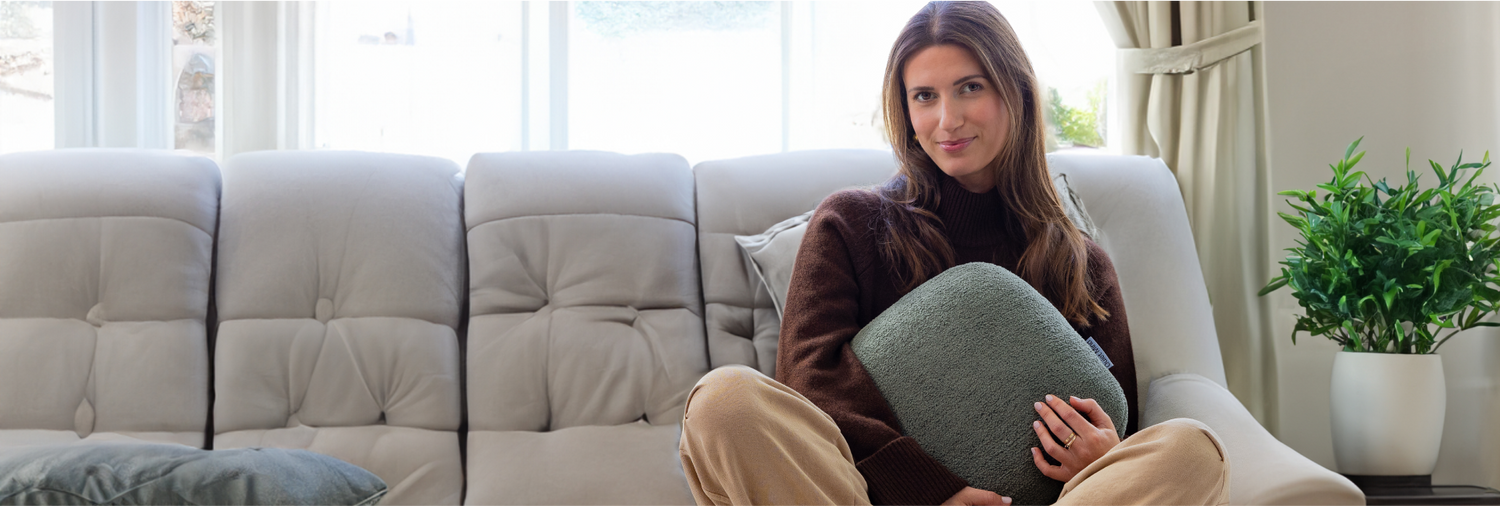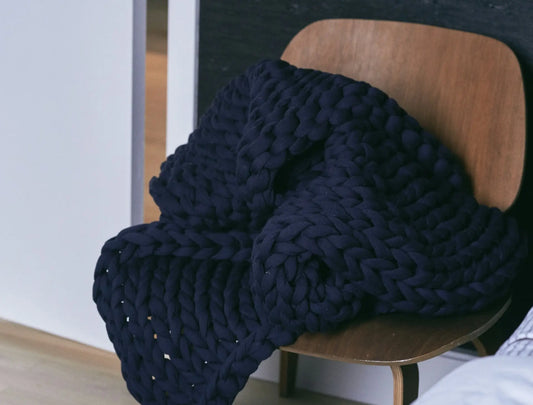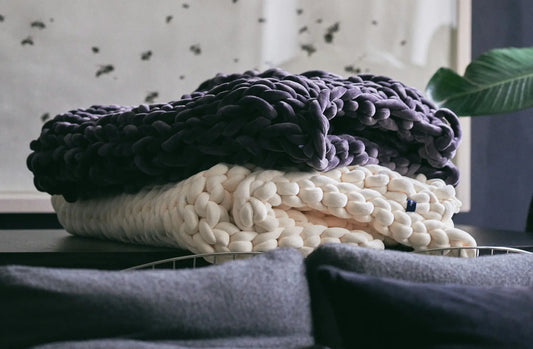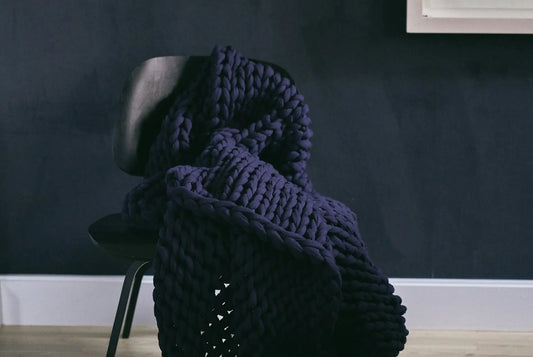A weighted blanket is designed to soothe, a steady, grounding presence that helps you feel more settled and supported. With regular use, it’s natural for it to pick up body oils, sweat, or everyday odors, especially if it’s part of your sleep or sensory routine.
For those who rely on its calming weight to manage anxiety, restlessness, or overstimulation, gentle care goes a long way in preserving both its comfort and effectiveness. Whether your blanket is filled with glass beads, poly pellets, or natural materials, knowing how to wash and dry it properly helps maintain its softness, structure, and sensory benefits.
This guide walks you through clear, material-sensitive care instructions to help your blanket stay fresh, functional, and ready to support your well-being.
Are Weighted Blanket Machines Washable?
Yes, weighted blankets are machine washable, but not all of them. Some types of weighted blankets can be cleaned in a washing machine or by hand, while others may need spot clean or dry clean treatment only. Whether your weighted blanket can be washed depends on its materials and care instructions provided by the brand.
Understanding Blanket Labels and Tags
Always check the tag on your blanket or consult the manufacturer’s care labelling rule before starting. These tags detail critical information about:
- Whether to wash your weighted blanket in a machine or by hand.
- The right wash cycle and water temperature.
- Whether to dry your weighted blanket in a dryer or air dry.
- Warnings about bleach, softeners, or whether to wring out the excess water.
If you’ve misplaced the label, visit the brand’s website or default to hand-washing to avoid damage.
Fill Types That Affect Washability
The materials inside your weighted blanket determine how to clean it safely. Here's a quick overview of types of weighted blankets and their washing guidelines:
|
Filling Type |
Machine Washable |
Care Notes |
|
Glass beads |
Yes |
Durable, can handle gentle machine cycles |
|
Plastic poly pellets |
Yes |
Avoid high heat to prevent warping |
|
Organic materials (rice, sand, beans) |
No |
Spot clean only, moisture may lead to mold |
If your blanket contains organic fillers, washing the entire blanket in water isn’t recommended. These natural materials can absorb moisture, which may compromise the structure and make thorough drying difficult. In these cases, spot cleaning or dry cleaning is the safest choice.
At Quiet Mind, our weighted pillows are thoughtfully made, which means they can be safely machine washed on a gentle cycle, using cool or warm water. This ensures our products stay soft, supportive, and easy to care for, so you can focus on feeling calm, not stressed about cleanup.
How to Wash a Weighted Blanket Properly
Once you’ve confirmed your blanket is washable, it’s important to follow the right cleaning process to maintain its structure, weight distribution, and softness.
Machine Washing Instructions
If your blanket is under 15–20 pounds:
- Use a gentle wash cycle and cold or warm water.
- Add a mild detergent (fragrance-free preferred.)
- Do not wring out the excess water, instead, press gently.
- Only wash with small items or alone.
- Never use bleach or fabric softeners.
If your blanket is too heavy for a standard washer, you may need to use a commercial washer at a laundromat or dry cleaner. This helps avoid strain on both the fabric and your home machine. Commercial washing equipment is designed to handle the weight safely.
Hand Washing in a Tub or Sink
Some weighted blankets are best hand-washed, especially those made with wool, silk, or other delicate materials.
To wash the blanket by hand:
1. Fill a tub or sink with cold water and mild detergent.
2. Submerge the blanket fully and gently agitate it.
3. Let soak for 15–20 minutes.
4. Drain, then press (don’t wring) to release water.
5. Rinse with clean water.
6. Lay the blanket flat to dry or hang it over a drying rack.
This method is ideal when you’re unsure about machine washing or when the care instructions vary by fabric. Lap-sized weighted pillows often follow the same gentle hand-washing approach.
Drying a Weighted Blanket Safely
Drying is just as important as washing. Improper drying can damage the inner filling or cause mildew buildup if moisture lingers too long.
Air Dry vs Dryer: Pros and Cons
|
Drying Method |
Pros |
Cons |
|
Air Drying |
Gentle on fabric and fill, preserves longevity |
Takes longer, may need large drying space |
|
Machine Drying |
Faster and more convenient |
Risk of melting plastic pellets, shrinking fabric |
Air drying is recommended for most blankets, especially those over 10 pounds or made with heat-sensitive materials. Weighted pillows, by comparison, are smaller and dry much faster, making them easier to care for regularly.
Dryer Settings and Precautions
If the label permits dryer use:
- Use low heat or air fluff settings
- Place the blanket with a few clean, dry towels to absorb moisture and reduce bounce
- Check frequently to avoid overheating
- Never use high heat or timed cycles
Overheating can damage seams, cause uneven weight distribution, or degrade the filler.
How Often Should You Wash a Weighted Blanket?
While it’s important to keep your weighted blanket clean, frequent washing can wear down the fabric and seams, especially if it's heavy or filled with delicate materials. The CDC’s laundry hygiene guidelines recommend washing bedding every 1–2 weeks depending on direct skin contact, sweat, or exposure to bodily fluids, which aligns with weighted blanket care best practices.
Daily Use vs Occasional Use
- Daily use (especially for sleep): Wash every 2–4 weeks.
- Occasional use (e.g., calming tool during the day): Wash every 1–2 months.
If used directly against skin or by children or pets, more frequent washing may be necessary, especially during warmer months.
Extending Time Between Washes with Covers
Using a removable duvet cover is one of the simplest ways to protect your weighted blanket and reduce how often it needs to be washed. Covers can typically be laundered weekly or biweekly, depending on use, and they help prevent buildup from sweat, oils, or spills. Opt for breathable materials like cotton or bamboo for easier maintenance and better airflow.
At Quiet Mind, our weighted pillows come with a removable, machine-washable cover, making day-to-day care simple and sensory-friendly. This allows you to keep your calming tools fresh and clean, without the need for frequent deep washing.
Spot Cleaning and Stain Removal Tips
Weighted blankets don’t always require a full wash. Spot cleaning is effective for small spills, stains, or specific areas of buildup.
Products and Techniques for Spot Cleaning
Use a mild, fragrance-free detergent or a gentle stain remover diluted with water. Soft sponges or microfiber cloths are ideal.
Steps:
1. Blot the stain with a damp cloth, do not rub.
2. Apply a diluted detergent solution.
3. Gently dab until the stain lifts.
4. Use a clean cloth and fresh water to remove residue.
5. Air dry the cleaned area thoroughly.
Avoid harsh chemicals or bleach, especially on dyed or organic fabrics.
When to Skip the Full Wash
You may skip full washing if:
- Only small areas are dirty.
- There’s no odor or heavy sweat buildup.
- You’re using a protective duvet cover that’s been cleaned.
Spot cleaning helps preserve stitching and internal structure while keeping your blanket fresh between full washes.
Dry Cleaning Weighted Blankets: When Is It Necessary?
Some weighted blankets, especially those made with wool, silk, or luxury fabrics, may be labeled “dry clean only.”
Dry Clean Only Labels and Alternatives
Always follow the label’s recommendation. If your blanket:
- Contains non-washable organic fillers (like rice or beans.)
- Has a delicate outer fabric prone to damage in water.
- Includes leather, suede, or silk covers.
Then dry cleaning is the safest route. However, for most everyday weighted blankets, hand or machine washing is preferred due to the chemicals used in dry cleaning, which may not be suitable for sensory-sensitive individuals. Weighted pillows, being smaller and easier to manage, rarely require dry cleaning, making them a more practical choice for daily use.
Weighted Blanket Care Based on Filling Material
Different fill types require different levels of care. Washing improperly can cause leakage, mold, or breakdown of the inner material.
Cleaning Blankets Filled with Sand, Rice, or Beans
These organic fillers are not washable.
- They retain moisture, which promotes mold and odor.
- Avoid full washing, use spot cleaning only.
- Use a protective cover at all times to reduce exposure to spills or dirt.
If your blanket contains these materials and gets wet, it may need replacement, as drying them fully is difficult and often ineffective.
Washing Blankets with Glass Beads or Plastic Pellets
These are the most wash-friendly options.
- Glass beads: Heavier but highly durable. They can withstand cold machine washes and air drying, making them ideal for long-term use.
- Plastic pellets: Lighter than glass beads and safe for machine washing, but they must be dried on low heat only to prevent melting or clumping.
The Alternative: Weighted Pillows
Quiet Mind uses glass bead filling in all of our weighted pillows for gentle, even pressure. We recommend washing the removable cover in cold water on a delicate cycle, and either tumble drying on low or air drying for best results. The inner weighted insert should be spot-cleaned only to maintain its structure and softness.
Weighted Blankets vs Weighted Pillows: Care & Cleaning Differences
Weighted blankets bring full-body comfort, but they also bring weight, bulk, and cleaning challenges. Pillows, on the other hand, are smaller, lighter, and easier to maintain.
|
Feature |
Weighted Blanket |
Weighted Pillow |
|
Machine Washable |
Depends on filler; may need commercial washer |
Almost always washable at home |
|
Drying Time |
Long (air dry recommended) |
Short (quick tumble or air dry) |
|
Spot Cleaning |
Tricky on large/heavy fabric |
Easy to manage |
|
Storage |
Bulky, requires space |
Compact, easy to store |
|
Best Use |
Nightly, immersive pressure |
Daily flexibility, lap, chest, or travel |
This doesn’t mean one replaces the other. Many people prefer a weighted blanket for nighttime and a weighted pillow for daily support. Together, they create a versatile toolkit that covers both deep rest and on-the-go calm.
Quiet Mind takes this versatility a step further. Each Quiet Mind weighted pillow is crafted for daily ease, with durable stitching, quick-dry fabrics, and evenly distributed glass bead filling that maintains balance even after repeated washes. Designed for real-life use, our weighted pillows offer a cleaner, simpler, and more practical way to enjoy the benefits of deep pressure therapy every day.
Final Tips to Keep Your Weighted Blanket in Top Shape
- Rotate the blanket occasionally to maintain even fill distribution.
- Store it flat or gently folded in a cool, dry place.
- Avoid storing in plastic bags or airtight containers, use cotton storage bags or breathable bins.
- If your blanket develops odor or mildew, try air drying in indirect sunlight and consider adding baking soda to a spot clean.
Caring for your weighted blanket gently and consistently ensures it remains a calming, reliable tool, not just for sleep, but for daily regulation and comfort.
About Quiet Mind
At Quiet Mind, we believe that stress relief doesn’t have to be complicated. Our signature weighted pillows are designed to offer gentle, grounding pressure, like a calming hug for your nervous system.
Whether you’re looking for a more restful sleep or a quiet moment of relief during your day, QuietMind provides tools that support your sensory and emotional well-being, naturally. Discover our weighted pillows and find your path to a quieter mind.
Frequently Asked Questions
Can I put my weighted blanket in a top-loading washer?
Only if it’s under the washer’s weight limit and doesn’t have a central agitator. Otherwise, it’s best to use a commercial washer or wash by hand.
Can I use a dryer for my weighted blanket?
Yes, but only on a low heat setting. Check the label and stop the dryer occasionally to fluff the blanket.
Should I remove the duvet cover before washing?
Yes. Wash the cover separately to protect both items and reduce friction during the wash cycle.
What if my blanket is too heavy for my home washer?
Visit a laundromat with commercial machines, or consult a dry cleaner if unsure about fabric durability.
Do I need to wash it every time there’s a spill?
No, you can spot clean as needed. Save full washes for when there’s odor, sweat build up, or widespread stains.
How do I care for my weighted pillow?
Our weighted pillows come with a removable cover that is machine washable. We recommend using cold water and washing on a delicate cycle. Tumble dry low or air dry for the best results. The inner weighted part should be spot-cleaned only.
